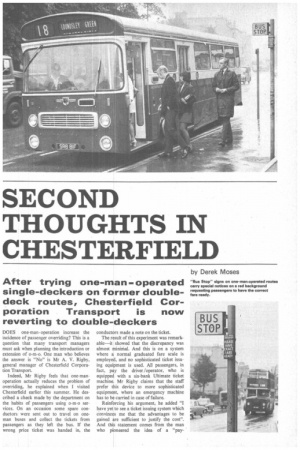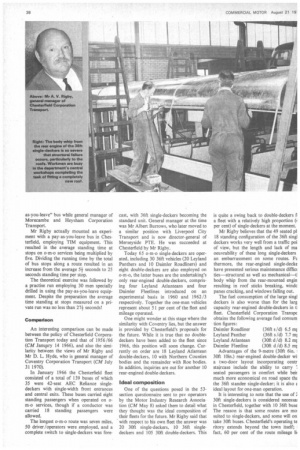SECONb THOUGHTS IN CHESTERFIELD
Page 39

Page 40

Page 41

Page 45

If you've noticed an error in this article please click here to report it so we can fix it.
After trying one-man operated single-deckers on former double deck routes, Chesterfield Cor poration Transport is now reverting to double-deckers
DOES one-man-operation increase the incidence of passenger overriding? This is a question that many transport managers must ask when planning the introduction or extension of o-m-o. One man who believes the answer is "No" is Mr A. V. Rigby, general manager of Chesterfield Corporation Transport Indeed, Mr Rigby feels that one-manoperation actually reduces the problem of overriding, he explained when I visited Chesterfield earlier this summer_ He described a check made by the department on the habits of passengers using o-m-o services. On an occasion some spare conductors were sent out to travel on oneman buses and collect the tickets from passengers as they left the bus. If the wrong price ticket was handed in, the conductors made a note on the ticket.
The result of this experiment was remarkable—it showed that the discrepancy was almost mininial. And this is on a system where a normal graduated fare scale is employed, and no sophisticated ticket issu ing equipment is used. All passengers, in fact, pay the driver /operator, who is equipped with a six-bank Ultimate ticket machine. Mr Rigby claims that the staff prefer this device to more sophisticated equipment, where an emergency machine has to be carried in case of failure.
Reinforcing his argument, he added "I have yet to see a ticket issuing system which convinces me that the advantages to be gained are sufficient to justify the cost". And this statement comes from the man who pioneered the idea of a "pay as-you-leave" bus while general manager of Morecambe and Heysham Corporation Transport.
Mr Rigby actually mounted an experiment with a pay-as-you-leave bus in Chesterfield, employing TIM equipment. This resulted in the average standing time at stops on o-m-o services being multiplied by five. Dividing the running time by the total of bus stops along a route resulted in an increase from the average 5+ seconds to 25 seconds standing time per stop.
The theoretical exercise was followed by a practise run employing 30 men specially drilled in using the pay-as-you-leave equipment. Despite the preparation the average time standing at stops measured on a private run was no less than 27+ seconds!
Comparison
An interesting comparison can be made between the policy of Chesterfield Corporation Transport today and that of 1956 /66 (CM Janu.ary 14 1966), and also the similarity between the views of Mr Rigby and Mr D. L. Hyde, who is general manager of Coventry Corporation Transport (CM July 31 1970).
In January 1966 the Chesterfield fleet consisted of a total of 139 buses of which 35 were 42-seat AEC Reliance singledeckers with single-width front entrances and central exits. These buses carried eight standing passengers when operated on om-o services, though if a conductor was carried 18 standing passengers were allowed.
The longest o-m-o route was seven miles, 50 driver/operators were employed, and a complete switch to single-deckers was fore
cast, with 36ft single-deckers becoming the standard unit. General manager at the time was Mr Albert Burrows, who later moved to a similar position with Liverpool City Transport and is now director-general of Merseyside PTE. He was succeeded at Chesterfield by Mr Rigby.
Today 65 o-m-o single-deckers are operated, including 30 36ft vehicles (20 Leyland Panthers and 10 Daimler Roadliners) and eight double-deckers are also employed on o-m-o, the latter buses are the undertaking's only rear-engined double-deckers, comprising four Leyland Atlanteans and four Daimler Fleetlines introduced on an experimental basis in 1960 and 1962/3 respectively. Together the one-man vehicles represent about 51 per cent of the fleet and mileage operated.
One might wonder at this stage where the similarity with Coventry lies, but the answer is provided by Chesterfield's proposals for the future. While it is true that no doubledeckers have been added to the fleet since 1966, this position will soon change. Currently on order are 18 Leyland Atlantean double-deckers, 10 with Northern Counties bodies and the remainder with Roe bodies. In addition, inquiries are out for another 10 rear-engined double-deckers.
Ideal composition One of the questions posed in the 53section questionnaire sent to psv operators by the Motor Industry Research Association (CM May 8) asked them to detail what they thought was the ideal composition of their fleets for the future. Mr Rigby said that with respect to his own fleet the answer was 20 30ft single-deckers, 10 361t singledeckers and 105 3011 double-deckers. This is quite a swing back to double-deckers f a fleet with a relatively high proportion (■ per cent) of single-deckers at the moment.
Mr Rigby believes that the 49 seated pl 18 standing configuration of the 3611 sing] deckers works very well from a traffic poi of view, but the length and lack of ma oeuvrability of these long single-deckers an embarrassment on some routes. Ft thermore, the rear-engined single-decke have presented serious maintenance diffict ties—structural as well as mechartical—t1 body whip from the rear-mounted engin resulting in roof sticks breaking, windc panes cracking, and windows falling out.
The fuel consumption of the large singl deckers is also worse than for the larg capacity rear-engined double-deckers in tl fleet. Chesterfield Corporation Transpc obtains the following average fuel consum lion figures: Daimler Roadliner (36ft s/d) 6.5 mi Leyland Panther (36ft s /d) 7.7 ml Leyland Atlantean (30ft d /d) 8.2 mt Daimler Fleetline (3011 d /d) 8.5 rnt Advantages of the 9-metre (30ft 6in. 3011 10in.) rear-engined double-decker wi a two-door layout incorporating centr staircase include the ability to carry seated passengers in comfort while beit much more economical on road space dm the 36ft standee single-decker; it is also t ideal layout for one-man operation.
It is interesting to note that the use of 3011 single-deckers is considered necessai in Chesterfield, together with 10 36ft buse The reason is that some routes are ma suited to single-deckers, and some will on take 3011 buses. Chesterfield's operating te ritory extends beyond the town itself; fact, 60 per cent of the route mileage Hi outside the borough boundaries, with joint services operated with East Midland and Sheffield City Transport. However, 60 per cent of the actual car miles operated by Chesterfield buses lies inside the boundaries.
Further operation beyond the boundaries will occur when proposals to serve, jointly with East Midland, large new development areas adjacent to Staveley, to the north-east of Chesterfield, are implemented. The latter company operates 48 Leyland Atlantean double-deckers and is introducing another five this year—its total fleet of doubledeckers was 78 in 1968—and the company's first Bristol double-deckers, five VRT rear-engiried models, are due next year.
How many doors?
Another feature of one-man buses which is receiving much attention from the psv industry is the attempt to determine how many doors shonld be provided, particularly on G-M-0 double-deckers. Both Mr Rigby and Mr Hyde were divided on this issue. The former told me he had mixed feelings about one door. It was something which depended on the type of route—for example, the Chesterfield—Sheffield service.
Mr Rigby said that he had nothing to complain about with two doors, although he preferred the exit to be as close to the entrance as possible. This feature (employed on Chesterfield's latest single-deckers) improved visibility for the driver as the majority of standees were behind the exit. The 18 double-deckers on order specified a ite exit and centrally mounted stairthough later double-deckers might to the single front doorway.
Hyde, who has specified the two-door on Coventry's latest buses, following :decessor's policy, admitted to me that t many routes did not require buses . second door. In fact; Coventry Coron Transport has studied a cross-town : which was operated by one-door named double-deckers before conver:o o-m-o. On conversion, two-door :-deckers were introduced, and, , the service was restored to one-door double deckers. Mr Hyde believes h deeper study is required.
:standing buses on order for Coven3 explained in CM July 31, are two a of Fleetline double-deckers, the first
fitted with two-door bodywork. ver, there is a strong possibility that :and batch (28 out of a total 56) will . front entrance /exit only.
notable difference between Covenpolicy and that of Chesterfield is that mer undertaking is dedicated to a 100 nt change to o-m-o, and will implethis change as quickly as possible, Mr Rigby is working towards 90 per i-m-o only. In Coventry's case the in is demanded largely by the staff an—while there is not a large turnhere are not many recruits coming d. Two women drivers are now yed, one of them being a driver /opera
would make the operation of additional buses a necessity. To date, the switch to 0-m-o has been accomplished without increasing the size of the fleet.
More buses Chesterfield estimates that to convert the busiest services to o-m-o would need an additional six to eight buses. The question of redundancy would also be aggravated. Mr Rigby told me, which suggests that the staff position is not so acute there as in some undertakings. Keeping the fleet size down is also another consideration against the introduction of more single-deckers. Doubledeckers on a 10-minute frequency service can cope with 492 passengers an hour; additional vehicles would be required if a switch to single-deckers were made.
Although complete adoption of o-m-o has been rejected, proposals to convert all Sunday services, and weekday services after 6.30 pm, to o-m-o, are being considered, although this is in its early stages. The undertaking has, I understand, received utmost co-operation from the union on each stage of conversion.
Before a route is switched to o-m-o, extensive publicity is given, starting at least two weeks before the changeover. Two days before the change, red plates bearing the message "one-man route, please have correct fare ready" are attached to the appropriate bus stop signs. In practice, about 66 per cent of Chesterfield's passengers tender the correct fare on one-man services.
The forecast in CM in January 1966 may not have been borne out by subsequent events, but the extent to which our predictions were wrong reflect the adaptability of busmen to keep abreast of development in the industry. It will be interesting indeed to see what is happening in Chesterfield in another 4-1years' time.














































































































